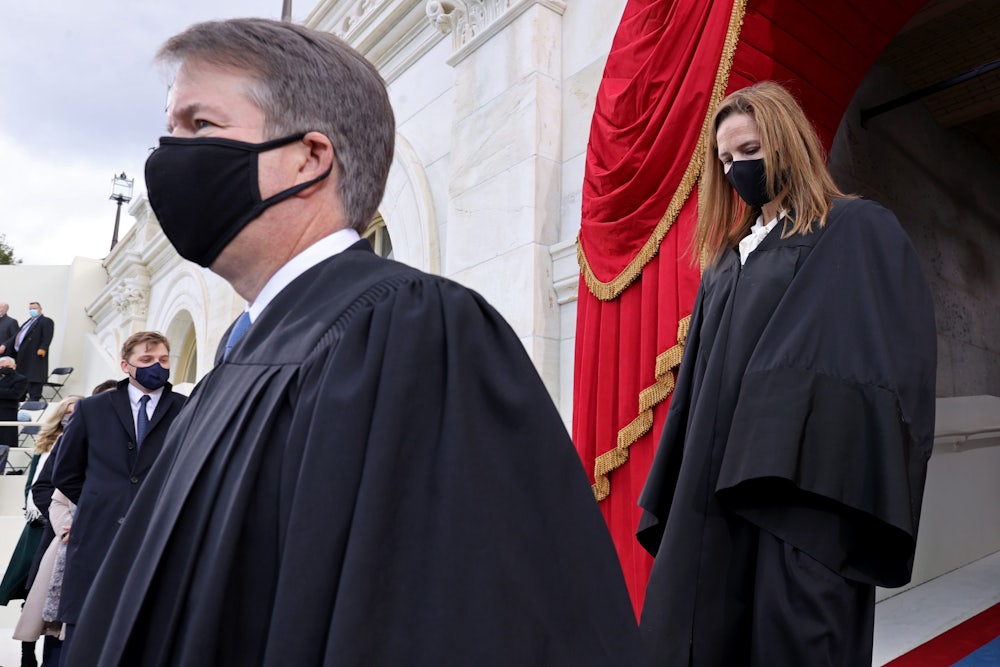The Supreme Court announced on Monday that it would hear its first abortion-related case since Justice Amy Coney Barrett’s confirmation last fall. The case, Cameron v. EMW Women’s Surgical Center, is not a direct challenge to the court’s abortion-rights precedents and provides no opportunity for the court’s conservatives to overturn Roe v. Wade. But the justices could yet give Republican officials more flexibility when defending restrictions on the procedure. Importantly, the case may also shed some light on where the Supreme Court’s resurgent conservative bloc will go next on abortion.
On one side of the dispute is the only clinic in Kentucky licensed to perform abortions, which is challenging a state law passed in 2018 that prohibits a specific type of abortion procedure commonly performed during the second trimester. On the other side are state officials defending that law.
The clinic filed its lawsuit in 2018 against multiple officials, including then–Attorney General Andy Beshear, the state medical board, a state prosecutor, and the Cabinet secretary for health and family services. A few weeks later, Beshear, a Democrat who would declare his candidacy for governor later that year, and the state medical board moved to withdraw from the case. While obtaining the clinic’s assent to withdraw, Beshear agreed to stipulate to the court that the court’s eventual ruling on the constitutionality of the law “will be binding on the Office of the Attorney General” unless that ruling was overturned on appeal.
In May 2019, the district court sided with the clinic and struck down the law. The Cabinet health secretary, acting on behalf of Republican Governor Matt Bevin’s administration, was the only state official who opted to appeal that ruling. Before the Sixth Circuit Court of Appeals held oral arguments in the case, however, Beshear won the 2019 gubernatorial election, and Republican Daniel Cameron won the election to replace Beshear as attorney general. The four lawyers who represented the health secretary got new jobs in Cameron’s office. Strangely, they continued to defend the law on the secretary’s behalf, even though they now worked for the attorney general’s office, which no longer had a role in the case.
This partisan switcheroo did not immediately affect the case or its trajectory. Last June, a Sixth Circuit panel upheld the lower court’s rulings in favor of the clinic. After that ruling, the secretary decided not to appeal the case any further. But Cameron sought to re-enter the case last year on behalf of the attorney general’s office, even though that office had already removed itself from the case under Beshear and stipulated it would accept the outcome. The Sixth Circuit panel rejected Cameron’s request, and Cameron instead asked the Supreme Court to let his office back into the case in October. That’s the issue the justices are considering: not the original law itself, but whether Cameron can rejoin the legal battle over it.
To support his position, Cameron argued in his petition for certiorari that state law makes him the final arbiter of when a state will stop pursuing appeals in litigation. He also leans on the secretary’s decision to keep the lawyers from the governor’s office after they moved to the attorney general when the two offices switched parties, implying his office was still involved in the case in some capacity. (Cameron also used his petition to ask the court to vacate the lower courts’ rulings because of the Supreme Court’s ruling in June Medical Services v. Russo last year. The Supreme Court, however, declined to take up that question.)
The American Civil Liberties Union, which represented the clinic in the litigation, criticized Cameron’s maneuver as an “eleventh-hour” attempt to reverse the outcome. “This case is only about whether [Cameron], after having sat on the sidelines of this lawsuit, can jump in at the last minute in an effort to revive an unconstitutional law,” Andrew Beck, a senior attorney at the ACLU’s Reproductive Freedom Project, said in a statement on Monday. “The attorney general has shown that he will stop at nothing to prevent people from making their own decisions about a pregnancy. Major medical associations have condemned harmful restrictions like the one at issue here, and every court to consider a law like this has blocked it.”
In theory, this case only involves a narrow procedural dispute over whether the Kentucky attorney general’s office can once again intervene in the lawsuit after withdrawing from it two years ago. But it still carries significant political and practical stakes. Cameron quickly touted his success at getting the Supreme Court to hear the case, explaining on Twitter that the justices “will decide whether my office can defend this important law, which prohibits live dismemberment abortions of unborn children.” If Cameron succeeds on the procedural question, he would have the opportunity to ask the Supreme Court to revisit the Sixth Circuit’s ruling on the merits, which could lead to the Kentucky law’s reinstatement.
The technicalities in this case could matter a great deal. One issue on which Cameron wanted to intervene in the lower courts was whether the clinic had standing to challenge the Kentucky law in the first place. The Supreme Court has long allowed abortion clinics to litigate restrictions that affect their patients, but Justices Clarence Thomas, Samuel Alito, and Neil Gorsuch indicated in their June Medical Services dissents that they would vote to deny third-party standing to clinics in the future. If the court addresses that issue here, it could indicate the court’s conservatives will be more aggressive in opposing challenges to abortion-related restrictions going forward.
The case could also be a chance to see how the Supreme Court will approach abortion-related cases with six conservative members. Anthony Kennedy’s retirement in 2018 left the court without a clear fifth vote in favor of the status quo on abortion rights. But even after Justice Brett Kavanaugh replaced Kennedy, the court also appeared to lack five votes to uphold state laws that would sharply restrict abortion access. Chief Justice John Roberts voted with the court’s four liberals in June Medical Services last year to block a Louisiana law that would have closed all but one of the state’s abortion providers. He wrote separately that the court’s ruling on a similar Texas law four years earlier deserved respect as precedent, even though he had dissented from it at the time.
As long as Roberts remained the court’s swing vote, most observers assumed the court wouldn’t make any sudden moves on abortion rights. But Ruth Bader Ginsburg’s death last September changed that calculus. Justice Amy Coney Barrett, who was sworn in a month later, had an unusually clear record of anti-abortion advocacy as a private citizen for a Supreme Court nominee. Accordingly, activists on both sides of the debate expect that she will be inclined to uphold state laws that are designed to limit access to the procedure. Barrett could even provide a fifth vote to overturn Roe and Planned Parenthood v. Casey, the twin pillars of modern abortion-rights jurisprudence.
That won’t be the question that the justices consider when they hear oral arguments in the case later this fall. But it’s hard to imagine it will be far from their minds. How they handle this procedural dispute could determine whether Republican state attorneys general have greater leeway to defend abortion-related restrictions in the courts going forward. And it may even provide some indication about how the justices themselves will address the question looming over them for the last few years: With its conservative supermajority secured, will the Supreme Court actually bring the Roe-Casey era to an end?








